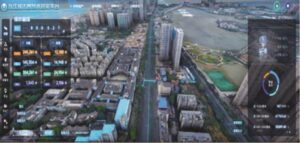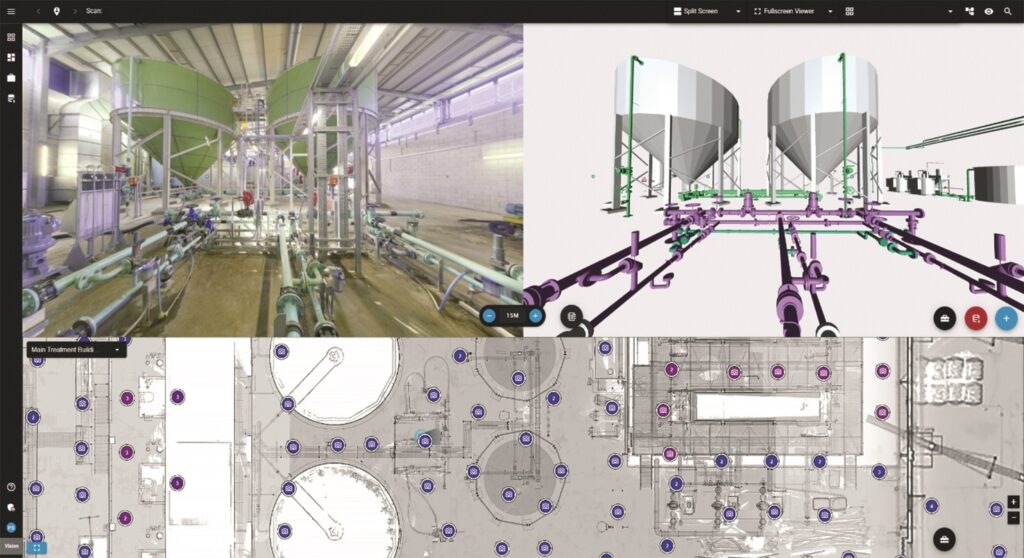Chair of IWA’s Digital Water Programme Oliver Grievson presents case studies from Brazil, China and the UK that show how digitalisation is transforming the capabilities of the water sector.
Digital transformation and digital water are concepts that have been present in the water industry for many years – yet it is fair to say that their adoption has been somewhat mixed. Depending on where you are in the world, the industry has many and varied challenges, but underpinning all of this is Sustainable Development Goal (SDG) 6, the need to “ensure availability and sustainable management of water and sanitation for all”. The progress on the goal has been slow at best. In 2021, the UN reported that “the world – on average – must quadruple current rates of progress to have a chance to achieve SDG 6 by 2030”.
When we look at digital transformation, there has been some confusion about what it actually means. For me, at least, it is a collection of digital tools that we – as a global industry – can use to inform us of our performance and what needs to be done, be this in addressing greenhouse gas emissions (GHGs), reducing energy intensive processes through operational and asset management efficiencies, or limiting the polluting impact that the water industry can have.
In this article, I look at three examples of where digital transformation has been used:
- To help reduce the impact on people from heavy storms caused by climate change in Brazil, using LoRaWAN.
- Using a wastewater collection network digital twin to increase efficiency and reduce pollution incidence in China.
- Using advanced asset management laser-scanning technology in the UK to increase the efficiency of design and operational management.
Managing climate change resilience in Brazil

The first case study shows how digital transformation can be used to increase urban resilience.
The IPCC Sixth Assessment Report (AR6) projects a 1.5-fold increase in heavy storms across the globe, even under scenarios of a more conservative rise in temperatures. This increase in heavy storms is already being experienced, with flood events occurring in many different countries, including Pakistan, Brazil and Germany.
“digital tools can help increase the urban resilience cycle”
Given that 55% of the world’s population lives in urban environments (UN DESA, 2019), there is an urgent need to strengthen the urban resilience of water, sanitation and stormwater drainage infrastructure. The use of digital tools can help increase the urban resilience cycle through the three steps of response: rehabilitation, mitigation and preparedness.
One example of this is the use of a telemetric hydrological monitoring system using a Long Range Wide Area Network (LoRaWAN) developed by the company Asthon Tecnologia, to monitor, predict and send alerts of extreme hydrological events in the urban area of Itajuba, a medium-sized city located in Brazil.
The Sapucai River is the main watercourse that crosses the urban area of the city and has a long history of major floods. In recent years, flash floods of tributary streams of the Sapucai River – within the urban area – have become more frequent. Intense, short-term rains cause riverbanks to overflow and streets to flood in several neighbourhoods. The mountainous and complex terrain requires a high density of monitoring stations, so that the full spatial variability of rainfall is captured. Furthermore, the response time of the basins is short, requiring telemetry measurements at very short intervals.
As Itajuba is a medium-sized city, monetary resources are limited, so the development of the telemetric system with LoRaWAN was chosen as a low-cost solution. This consists of a digital circuit board, which is extremely compact, with low energy consumption, requiring a small battery with a charge that can last for months without needing a solar panel for recharging. The sensors used are nationally manufactured and low cost.
The entire development of the system is based on several years of cooperation between team members and municipal civil defence teams. Their experience made it possible to identify the municipality’s requirements in relation to the occurrence of extreme hydrological events. During the operation of the system and the collection of hydrological data, an ANN Application for Water Quality Forecasting is being trained to help increase accuracy in predictions.
Wastewater network digital twins in China
This second case study looks at the rapid development of a wastewater network digital twin, which was created to allow a low maintenance approach with comprehensive monitoring to enable facilitated operational management.

The project was delivered in the People’s Republic of China, in Jiujiang, an underdeveloped area along the Yangtze River in Jiangxi Province. The area faced numerous challenges in the management of its wastewater collection network, which meant there was an absence of effective measures for managing urban flooding and overflow pollution, and a limited capability for the management of risk and proactive control.The project brought together data from multiple sources – including operations, workforce, water assets and instruments, work processes, monitoring data, and numerical models – to form a high-quality data platform and a smart monitoring system.
The development of the digital twin approach enabled the concept of the Urban Smart Water Steward in China to promote the integrated management of urban water and the environment, embracing water resources, raw water transportation, water treatment and distribution, wastewater collection and treatment, the drainage network, sludge treatment, and open water.
Leveraging GIS, dynamic monitoring, numerical simulation and big data enhances smart water applications, and fosters cross-departmental collaboration and efficient sharing of information.
The concept established a centralised, remote-control system that enables smart decision-making and dispatch planning. This approach reduced the likelihood of urban flooding and combined sewer overflows, enhanced the drainage system’s ability to respond to emergencies, and increased public satisfaction.
The platform serves an area of 80 km2 in the urban area of Jiujiang, encompassing four wastewater treatment plants, 1929 km of drainage pipe networks, more than 70 pumping stations, three regulating reservoirs, and associated pipe, river and lake facilities, providing for a population of 2.51 million.
Since it launched, a total of 316 user accounts have been activated, with the accumulated amount of monitoring data exceeding a billion. Daily water operation and management data has exceeded more than 49,600 entries.
In addition, model prediction data that assists in operational decision-making has exceeded approximately 10 million entries. The project has resulted in more than 10 patents and more than 40 software copyrights.

The project’s achievements include:
- 38% improvement in operational and maintenance efficiency;
- 26% improvement in energy efficiency;
- 60% reduction in maintenance failure rates;
- 80% of process operations and safety training being based on the digital twin application technology;
- in-depth data mining and analysis that has enabled six successful cases for pollution source tracing and source pollution control;
- an educational resource for future generations of water engineers, attracting more than 100 visits each year from a variety of stakeholders.
Increasing asset management efficiency in the UK
This case study looks at the application of Building Information Modelling (BIM) technology to provide effective asset management and design in both potable and wastewater management in the UK.
The water industry is a complex asset management industry, which, because of its size, is constantly transforming, with an extension of assets because of population growth, climate change, and increasing environmental needs. Engineering design has gone from draughtsmen working on paper to various increasingly complex methods for capturing information around the industry’s assets.
“accuracies of surveying are now down to the millimetre”
Twenty years ago, paper manuals would have been used to capture how all of these assets were working as a system. Modern ways of working instead use laser-scanning and capture assets in a point cloud. The technology has developed to the extent that accuracies of surveying are now down to the millimetre.
Digital tools enable a large degree of remote working, reducing the need for engineers to go onsite when working on designs, cutting down on travel and its associated carbon emissions. This also enables more efficient design to take place, with digital technology able to record assets in locations that are difficult to access and scanning to detect failing assets, enabling proactive maintenance.
In this case study, digitalisation allowed the operator to rapidly ascertain the as-built status of the site without operational disruption, resulting in updates to key information, such as documents and drawings. Digitalisation of this asset improved understanding of the client’s equipment inventory, aiding operational teams with easily accessible data that helps in preparation for site scopes. The visual condition assessment, conducted through a programme called Vision, identified unknown issues and prompted remedial actions.
The future
Digital tools are increasingly being used to help the water industry operate in a more efficient way across the globe, increasing operational and asset management efficiency, serving the public in a more enhanced way, and, ultimately, protecting the environment more sustainably. Digital tools have a huge potential to benefit the sector – and this is just the beginning. •
More information
IWA’s Digital Water Summit will take place on 12-14 November in Bilbao, Spain. To find out more, visit digitalwatersummit.org
The author: Oliver Grievson is an Associate Director at the global engineering consultancy AtkinsRéalis and a Royal Academy of Engineering Visiting Professor of Digital Water at the University of Exeter. He is also Chair of IWA’s Digital Water Programme
The author is grateful for the case studies provided by Marina Batalini de Macedo, of the Universidade de Itajubá, Brazil; Yufeng Guo, of Three Gorges Smart Water Technology, China; and Gareth McIntyre, of GDi, UK.








